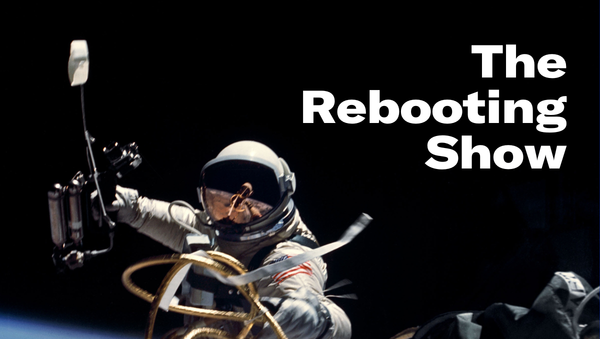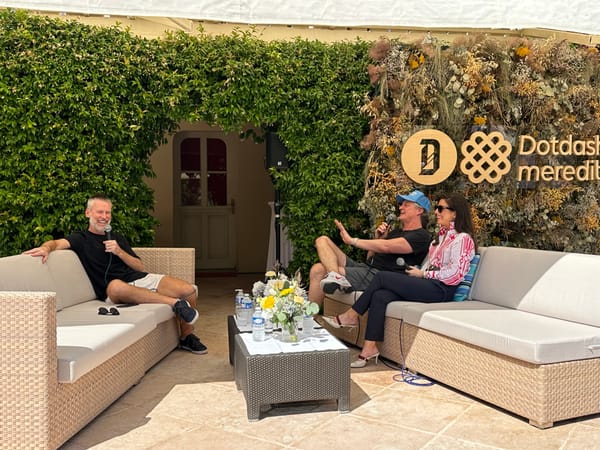Storylines of 2021
An uneven recovery and a flight to focus
Welcome to a holiday edition of The Rebooting. I appreciate everyone reading and subscribing. Starting something new is hard, and the cliche rings true that everything worthwhile takes twice as long and is twice as hard as anticipated. Discovery is the biggest challenge with newsletters, so I appreciate you passing this along to anyone you believe would find it valuable. Also, if you are not yet a subscriber, please sign up to receive The Rebooting. It comes out twice a week, Mondays and Wednesdays.
Many of the hopes for a resurgent 2021 in the media business didn’t come to pass, but the year was hardly a disaster. SPACs were not, in fact, a way out for businesses that have no track record at profitability. Yet the ad business was surprisingly perky. Two big growth areas for digital publishers – subscriptions and commerce – showed signs of slowing growth. Still, many publishers have far more diversified business models now compared to five years ago. Finally, for flameouts like Ozy there are plenty of gritty success stories of publishers building sustainable business models. These are my three top storylines of the year for the media business.
The Trump Slump was real.
In many ways, 2021 kicked off the pivot to reality. The giddiness of Hot Vax Summer gave way to the Delta wave, which unfortunately was an appetizer for the far larger Omicron surge we’re only at the early part of in most countries. On the economic front, the withdrawal of the unprecedented stimulus measures taken by governments is a wake-up call that coasting on cheap capital isn’t realistic in the long run.
For news publishers, 2021 marked the end of the stimulus package it was given by Donald Trump. For someone who enjoys calling the press “enemies of the people,” Trump sure was good for the news business. The New York Times has benefitted from its efforts to diversify into lighter fare like cooking and puzzles, but other publishers are not as lucky. Take The Washington Post. It has seen traffic decline 28% this year while its paid subscription base has shrunk 10 percent since the start of the year. At Politico, traffic is down 48%. The Times is off 15%.
The Times is the undisputed leader in the news category, at least in the U.S. It has continued to pile up big subscriber numbers, now with 7.6 million paid subscriptions. But in its recent earning call, CEO Meredith Kopit Levien warned it expected to churn more subscribers in the fourth quarter as sweetheart intro offers put out during the presidential election expire and rates are jacked up to full price. The acquisition of The Athletic is one sign that the Times knows its drive to 10 million is not going to happen just by covering the intrigue of Joe Biden’s legislative maneuvering with a politician from West Virginia. (On cable news, the situation is even more dire. Trump’s preferred form of media had a codependent relationship with him. The prime audience for CNN is down 77% and Fox News is down 35%.)
Trump was right about one thing: His drama was great for the news business.
The scale era fades in importance.
In basketball, the team down all game simply tries to extend the game in the hope of a series of circumstances presenting themselves in order to steal a win. Sometimes it happens. In 2021, you could see a set of circumstances enabling the big digital media companies to have a reset. The macroeconomic environment was defined by too much money chasing too few opportunities. SPACs emerged as a shortcut to the IPO process, and a path to the exits for impatient backers. And on top of that, every digital media company benefited from a surprisingly frothy ad market. It wasn’t meant to be.
BuzzFeed’s move to the public markets turned into a setback. The neat argument BuzzFeed made to investors centered around it using scale to drive an efficient, diversified business. One problem: The market didn’t assign much credibility to that message coming from a company that’s never turned a real profit for a full year.
The hope for many big digital media companies was the sudden resurgence of interest in SPACs would allow them to reset their businesses, armed with a new currency to acquire more businesses. But the SPAC market has cratered. When word came out that many investors in the SPAC merging with BuzzFeed would withdraw their money rather than own a piece of BuzzFeed, I wondered how big of a percentage it would be. Needless to say, 94% redemptions is not good. You can’t back that up to general sentiment. It’s a damning assessment of the value not just of BuzzFeed combined with HuffPost combined with Complex, but also of the prospect for several large digital media holding companies.
It came as no surprise that Forbes might not make it to the public markets. Vice Media had already thrown in the towel. Vox Media, after swallowing Group Nine, does not appear in a rush to get the kind of brushback BuzzFeed got. The pendulum in the media business has been moving for years away from this notion that you can be all things to all people. There is an attractive thesis that says the internet busts through typical category constraints. But spreading yourself far and wide is a risky strategy. The frequent end result is a brand that’s overstretched and wafer-thin.
Subscriptions aren’t the only business model in media – the best way to make money remains many ways – but they’re almost impossible to pull off if you’re mid-market and certainly below. It’s noteworthy that none of the big VC-backed digital publishers has a large subscription component to their businesses. They were built to be advertising businesses, and the assumptions of the ad market, for the most part, turned out off. Yes, the gap between time spent and budgets spent was narrowed, but nearly all that money went to tech platforms, not publishers. Scale ended up an albatross.
The flight to focus.
Contrast the fate of BuzzFeed with Politico. In August, Axel Springer bought Politico for $1 billion, a remarkable sum for a publisher without venture backing that sprang out of the once sleepy market for Capitol Hill publications. With money flooding into Washington to influence legislation, Politico occupied a lucrative niche, marrying the broad reach of a consumer publication with the pricey ads and subscriptions offerings of B2B. That turned out a better bet than native ads.
What Politico got right was going narrow and deep. That’s the story of Substack, for the most part, enabling writers to build mini-media businesses. Many of the most successful Substacks are narrow in focus – that’s inevitable if there’s just one person – and try to appeal to the 1,000 true fans. Racking up 1 million paid subscriptions is a big deal. Building a digital media business was always premised on scale, which usually meant trying to game some distribution channel, whether that’s search or social. And inevitably, scale approaches are dictated by the need for big numbers to support advertising businesses. The unbundling of publishing is changing that.
Niche media is ideal for alternative business models because it is premised on depth instead of breadth. The most powerful media brands are often not based on trying to convince brands to move money from TV into fancy banner ads. The resurgence of fortunes for sports media is a great example of how media is very valuable with the right business model. Sports media is lucky to be in the midst of a boom in legal sports gambling in the U.S., as providers scramble to acquire betters any way they can. Owning endemic media can be a very efficient acquisition channel.
The same goes for areas like food, which has been transformed from an SEO backwater into direct-to-consumer brands on the back of e-commerce operations. Why sell banner ads for pots and pans when you can just sell the pots and pans yourself?


For the final episode of the year of The Rebooting Show, which is released on Monday, I spoke with longtime Publicis Groupe executive Rishad Tobaccowala about his reflections of the year of accelerations – and what ends up sticking out of the pandemic. Rishad has a great newsletter called The Future Does Not Fit In The Containers Of The Past in which he covers these issues. You can hear Rishad speak on similar topics at the Mediaocean Retreat, an event running during CES at the Cosmopolitan of Las Vegas. Attendees can join in person or virtually. Rishad is one of several keynotes and panels from leaders in the ad and media industries, including Twitter chief customer officer Sarah Personette, Cadillac CMO Melissa Grady and S4 Capital CEO Martin Sorrell. The Mediaocean Retreat runs from Wednesday, Jan. 5, through Friday, Jan. 7. Co-working facilities for in-person attendees and anyone can join the livesteream. Learn more and register.

Facebook isn’t one to let a tech trend pass without copying it. Six months ago, Facebook launched Bulletin, a Substack clone for newsletters from the likes of Malcolm Gladwell, Ian Bremmer and Mitch Albom. The self-reported results are… tepid. Just half of the writers have over 1,000 free subscribers. Considering the elevated profile of this group and the fact that Facebook has 2.6 billion users, I’d expect more traction. I mean, if Facebook can’t bring distribution, what’s the advantage? I’m reminded of how important focus is. This is the Main Thing for Substack; it’s a hobby for Facebook.
The media SPAC dream is dead. These outstanding media SPAC deals are zombies, whether they admit it or not. Forbes isn’t BuzzFeed – it makes money, after all – but Jonah Peretti was correct that BuzzFeed would end up being a “comp” for the sector. That comp – BuzzFeed’s share price is down 41 percent – isn’t looking so hot. Cue the talk that the Forbes SPAC might be short circuited by a buyout.
One safe media prediction for 2022: More dealmaking. The biggest digital media players will need to find a home as the nature of the scale era changes for good. Mathew Ingram notes that “the definition of sufficient scale is a constantly shifting target.”
This is the season for year-end podcasts. I was a guest on a pair this week. I spoke about my plans for The Rebooting (as well as other topics) with Jay Sharman on the Brand Story Inc podcast. Also, I was able to reunite with my longtime former colleague Mike Shields to talk end-of-the-year trends on his Next in Marketing podcast.
If you’re coming around to the idea that the world as we know it is a simulation, check out “The Anomaly,” a runaway hit in France that’s now translated to English. The plot revolves around an Air France flight from Paris to New York that arrives only to find a duplicate of the plane, and its passengers, had already arrived months earlier. It’s a fun book to end a(nother) crazy year.

Thanks for reading. I’m going to close the year out next week with The Rebooting Awards, my second annual callout of those making progress to building sustainable media business models. Shoot me a note with any thoughts or feedback by hitting reply or emailing me directly: bmorrissey@gmail.com.




